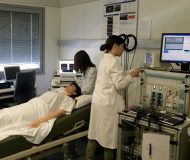

An international team with participation of the Cerebrovascular Diseases group at IIB Sant Pau and led by ICFO researchers, has carried out a pooled analysis, combining the results of three studies about the cerebral blood flow in cerebrovascular disease patients. The analysis concludes that the response of their cerebral blood flow to changes of the head-of-bed position can indicate failures in the brain’s autoregulation.
Ischemic stroke and brain self-regulation
Approximately 80% of the strokes that occur are of the ischemic type. An ischemic stroke is a cerebrovascular disease condition, caused by damage in the arteries (a narrowing or blockage of the vessels) that carry blood to the brain. The damage can cause a severe reduction in the blood flow, called ischemia, which can lead to the death of the brain tissue.
Cerebral autoregulation is a biological process working as a neural protection tool, carried out by our bodies to maintain the blood supply to the brain despite blood pressure changes, as occurs during the drug administration after injuries. Although many processes are involved in the cerebral autoregulation, the exact control mechanism is still unknown.
For patients who have suffered cerebrovascular accidents such as stroke, clinicians use different inclinations of the head-of-bed during the early stages of stroke, in order to improve the perfusion of blood flow to the brain. It is a non-invasive technique that does not require patient cooperation and the study of the cerebral response to this procedure may help to estimate the functioning of the mechanisms of cerebral autoregulation
Previous studies have indicated that approximately 25% of ischemic stroke patients respond to posture changes in an unexpected way. After changing the head-of-bed between lying flat and a degree of inclination, the blood flow of the brain does not return to the initial levels.
Researchers Clara Gregori, Igor Blanco, Peyman Zirak, Lisa Kobayashi, Stella Avtzi, Federica Maruccia and Giacomo Giacalone, led by ICREA Prof. at ICFO Turgut Durduran, have collaborated with researchers of the Cerebrovascular Diseases Group at IIB Sant Pau, consisted in the following neurologists from the Cerebrovascular Diseases Unit in the Hospital de Sant Pau, Pol Camps-Renom, Joan Martí-Fàbregas, Luís Prats-Sánchez and Alejandro Martínez-Domeño, led by Raquel Delgado-Mederos. The analysis, published recently in BMC Neurology, also includes researchers from the University of Pennsylvania, the Massachusetts General Hospital, the University of Campinas, and the Washington University of St. Louis. It investigates the relationship between these changes in blood flow and blood pressure, one of its main drivers.
Meta-analysis of seventy-two patients
To do a proper analysis on the matter, the team gathered data from three different studies, carried out between 2005 and 2017 in the United States and Spain, that included seventy-two patients with cerebrovascular disease. With this data, they performed a systematic analysis of the cerebral blood flow measurements.
All the data was obtained using diffuse correlation spectroscopy (DCS) techniques. The team measured the changes in cerebral blood flow, in response to a specific protocol for handling patients in bed, from three study subgroups: healthy individuals, patients with carotid stenosis (a narrowing of the carotid artery) and patients with ischemic stroke.
The head-of-bed protocol consisted of placing the patients in a supine position – lying on their backs -, then raising the head of the bed to an angle of 30º, and finally returning them to the initial position, maintaining each position for five minutes. During this process, researchers monitored the cerebral blood flow and blood pressure to see if there were any changes in the parameter.
Mobilizing patients could backfire
They analysed the data from all the patients of the subgroups and showed that, in healthy individuals, cerebral blood flow increases when they pass from a supine position to an elevated posture and then decreases to initial levels when they are lying down again. In contrast, in ischemic stroke and carotid stenosis patients, the cerebral blood flow and the blood pressure values do not return to baseline after postural changes.
Researchers observed that, during the first 48 hours after the stroke, the cerebral blood flow of these patients is correlated with the mean arterial pressure, only in the injured hemisphere of the brain.
These two observations suggest that these posture changes in stroke patients may be used to identify deficits or errors in the brain’s autoregulation response.
Helping to improve the management of stroke patients
Early mobilization of patients with ischemic stroke promotes the motor recovery. But the data provided by this analysis could suggest that moving patients during the first hours after the stroke may have an effect on the cerebral blood flow perfusion of the ischemic damage.
To study this issue in-depth, the team of ICFO researchers in collaboration with clinicians from the Hospital de Sant Pau and IIB-Sant Pau will carry out a clinical trial on 200 individuals who have suffered an ischemic stroke. They aim to clarify the role of cerebral autoregulation and provide more information to improve their clinical management.
Reference: Gregori-Pla et al. Blood flow response to orthostatic challenge identifies signatures of the failure of static cerebral autoregulation in patients with cerebrovascular disease. BMC Neurology (2021) 21:154. https://doi.org/10.1186/s12883-021-02179-8